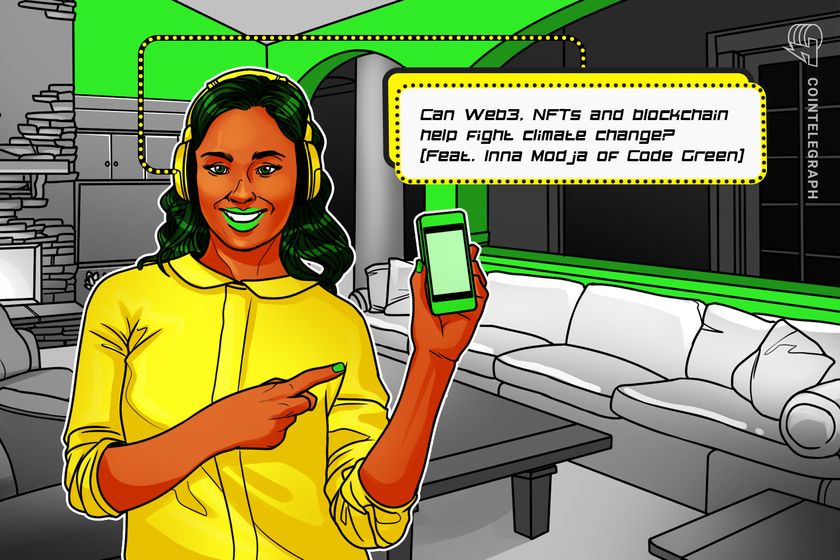Code Green co-founder Inna Modja explains how Web3 and art are at the vanguard of social activism and raising awareness about climate change.

Podcast
Since breaking on the scene, Bitcoin (BTC), Web3 and nonfungible tokens (NFTs) have positioned themselves as springboards for activism. The infrastructure and tools comprising the burgeoning crypto sector have positively impacted people from all walks of life, and the space continues to attract the brightest minds looking to solve some of the world’s most challenging problems.
While the general focus of most crypto protocols tends to be finance and fintech, there are a handful of projects focused more on socioeconomic, environmental and human rights-related issues. Code Green is one such project, focused on applying blockchain technology as a way to conduct social and environmental activism on a global scale.
On Episode 29 of The Agenda podcast, hosts Ray Salmond and Jonathan DeYoung welcomed Code Green co-founder Inna Modja to discuss how the nonprofit advocacy group is combining the power of art and Web3 to fight for a sustainable future.

Collaboration is key for Web3 and NFTs to succeed
Throughout the episode, Modja stressed the need for Web3 projects to be strategic and intentional, and to avoid the frequent outcome of new initiatives or collection launches, which can become focused on extracting profit from existing community members.
When asked about the role NFTs have played in Code Green’s philanthropic initiatives, Modja said:
“We are not an NFT project. Basically, all of the NFTs that we have done have been donated to people because we feel like if you want to support social or climate justice, you don’t have to pay for that. You can be part of the community and learn, get educated and contribute to this. So for us, […] we have the nonprofit side, which is something that is very important. And mainly, the majority of what we do is through that.”
In terms of charitable donations and philanthropy, Modja believes that “art is a very powerful tool to really bring awareness and to touch people and to move them to do something.”
Referencing the popular World of Women NFT project, Modja explained how Code Green managed the philanthropic wing of the blue-chip NFT project and curated donations to various organizations. She said, “We were in charge of a percentage of the sales of the new World of Women, the second generation of World of Women. And so this funding, it was around $2 million.”
Related: Bitcoin mining boosts the transition to renewable energy
Recognizing that the culture of charitable donating has evolved, Modja suggested that a more effective tactic for fundraising is to collaborate with entities that potential donors are already deeply involved with, and then direct the funds raised to various need groups.
“We don’t sell something, but through the collaboration, we raise funds to do that. And the only thing that we sold was through The Sandbox game, where people could buy if they wanted to — but they could still play if they didn’t want to buy anything. But the ones who chose to buy specific items, the money went to nonprofits and organizations that are supporting gender equality and climate justice. So for us, the model is not based on selling NFTs to do what we want. But maybe we will need, when we will create the app, we will need a model that will fundmake. But we always like to have that money through maybe bigger organizations or through, not through the community.”
To hear more from Modja’s conversation with The Agenda — including Code Green’s plan for 2024 — listen to the full episode on Cointelegraph’s Podcasts page, Apple Podcasts or Spotify. And don’t forget to check out Cointelegraph’s full lineup of other shows!
Magazine: ‘Treat your first NFT purchase like a first date’ — NFT Collector Suzanne
This article is for general information purposes and is not intended to be and should not be taken as legal or investment advice. The views, thoughts, and opinions expressed here are the author’s alone and do not necessarily reflect or represent the views and opinions of Cointelegraph.



